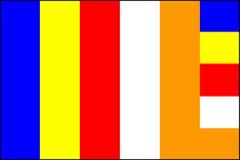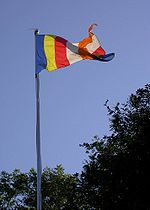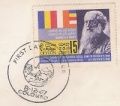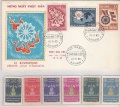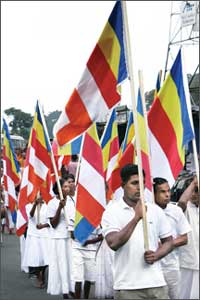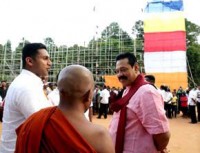Buddhist Flag: Difference between revisions
No edit summary |
|||
| Line 33: | Line 33: | ||
The colors of the flag have great significance as the six colors of the aura of the [[Gautama Buddha|Lord Buddha]]. | The colors of the flag have great significance as the six colors of the aura of the [[Gautama Buddha|Lord Buddha]]. | ||
<blockquote> | |||
The first five colours are arranged vertically as follows: blue, yellow, red, white, and orange. The sixth colour, called in Pali “Pabhassara”, which means “brilliant” or “radiant”, cannot be depicted but is symbolized by the combination of the first five colors arranged horizontally in a narrow strip on the right.<ref>"What is the Meaning of the Buddhist Flag?" at [http://wattampainenglish.com/136-buddhism/buddhism-faq/76-buddhist-flag.html Wat Tampa website].</ref> | |||
</blockquote> | |||
== Commemorative stamps == | == Commemorative stamps == | ||
Revision as of 14:17, 24 May 2018
The Buddhist flag is an emblem of the solidarity of all Buddhists. Introduced in Sri Lanka on April 28, 1885, the flag has been an enduring symbol among Buddhist groups and nations. Theosophical Society Founder-President Henry Steel Olcott had a role in the flag's development and popularization.
History of the flag
The Buddhist flag was first unveiled in Sri Lanka on April 28, 1885.
According to the Sri Lanka News":
(OGNP) Yesterday marked the 125th anniversary of the Buddhist Flag in the country. The inaugural ceremony of then Buddhist Flag designed and introduced by Sri Lanka was held on April 28 1885 on a Wesak Full Moon Day]] on Adhi Wesak Day. The Flag was originally designed in 1885 by the Colombo Committee.
This flag was published in the Sarasavi Sandaresa newspaper of 17 April 1885 and was first hoisted in public on Wesak day, 28 May 1885 at the Dipaduttamarama, Kotahena, by Ven. Migettuwatte Gunananda Thera.[1]
According to Southeast Asian Ministers of Education Organization:
The World Fellowship of Buddhists (WFB) is an international Buddhist organization which was founded in B.E. 2493 (1950) in Sri Lanka where representatives from 27 countries from Asia, Europe and North America met for the first time in history. Buddhist delegates from all over the world representing various schools of Buddhism, viz Theravāda, Mahayana and Vajrayana traditions, were unified under the six coloured flag.
The Buddhist flag, or the flag of Chabban narangsi, as approved by the World Fellowship of Buddhists at its inaugural conference in B.E. 2493 (1950) consists of six colours. The first five colors are arranged vertically as follows: blue, yellow, red, white, and orange. The sixth color, called in Pali “Pabhassara”, which means “brilliant” or “radiant”, cannot be depicted but is symbolized by the combination of the first five colors arranged horizontally in a narrow strip on the right. This six-coloured flag was originally designed by Colonel Henry S. Olcott, an American Buddhist, and has been used by the Sri Lankan Buddhists ever since. However, it gained wider recognition when it became the official flag of the World Fellowship of Buddhists at its inception in B.E. 2501 (1958). The design was based on the belief that wherever the Buddha went, he spread the light of wisdom and bliss to the people all around in six directions, namely, east, west, north, south, above and below. This light was later symbolized by the six colors in the Buddhist flag. However, for Thai Buddhists, a yellow flag with the symbol of the Wheel of Dhamma (Dhammacakka) has been in general use since B.E. 2501 (1958) when it was officially proclaimed by the Thai Sangha Authorities.[2]
Banning of flag by civil authorities
"In May 1963, in the central city of Huế, where Diem's elder brother Ngô Đình Thục was the archbishop, Buddhists were prohibited from displaying Buddhist flags during Vesak celebrations."[3] When a crowd protested the ban, forces of Diem's family opened fire and filled nine people. This precipated the "Buddhist crisis" in the war, involving use of curfews, riot police, and roadblocks to curb Buddhists who opposed the Roman Catholic regime.[4][5]
Design of the flag
The colors of the flag have great significance as the six colors of the aura of the Lord Buddha.
The first five colours are arranged vertically as follows: blue, yellow, red, white, and orange. The sixth colour, called in Pali “Pabhassara”, which means “brilliant” or “radiant”, cannot be depicted but is symbolized by the combination of the first five colors arranged horizontally in a narrow strip on the right.[6]
Commemorative stamps
Many commemorative stamps have been issued honoring the Buddhist flag.
Another stamp was issued on July 4, 2001 depicting Sri Dalad Maligaw and the Buddhist flag.[7]
80th anniversary celebration
125th anniversary celebrations
In 2010, the 125th anniversary of the first raising of the flag was celebrated in Sri Lanka.
According to the Sunday Observer:
Elaborate arrangements have been made to commemorate the 125th anniversary of the hoisting of the first Buddshist flag in Sri Lanka on April 28, 1885.
The historic event was held 125 years ago at Dipaduttaramaya, Kotahena, Colombo by Ven. Migettuwatte Gunananda Nayake Thera.
To commemorate this historic event, a special religious ceremony will be held on April 28, Full Moon Poya Day at Dipaduttaramaya Thai Raja Maha Vihara, Kotahena at 4 pm.
It will be followed by a State-sponsored Vesak week in May which include an essay and poem competition among Buddhist schools, issuance of a commemorative stamp and construction of a commemorative monument of the Buddhist Flag.
The events are organised by Prince College, Kotahena. Other Buddhist organisations will also be celebrating this historic event in various parts of the country.
The present incumbent of Dipaduttaramaya Thai Raja Maha Vihara, Ven. Waskaduwe Mahindawansa Anunayake Thera who heads the organising committee said the historic Buddhist flag will be hoisted again at its original place at 4 p.m. on this day amidst a gathering of Maha Nayaka Theras and State dignitaries.[8]
In another account:
The final Commemoration Ceremony to mark the 125th anniversary of the Buddhist Flag will be held under the patronage of Prime Minister D.M. Jayaratne, at Independence Square in Colombo today at 9.00 a.m.
A Buddhist flag will be hoisted at Independence Square. The State Engineering Corporation constructed the dais and the flag staff.
It has been designed by Aesthetic University, Visual Arts Faculty Dean Sarath Gunasiri. A commemorative stamp too will be issued at the ceremony.
A copy of ‘Buddhist Flag’, the Commemorative Journal will also be presented to the Premier. The program is being organized by the Colombo Buddhist Theosophical Society and the Buddhasasana and Religious Affairs Ministry. [9]
Sri Lanka News Today reported:
The final Commemoration Ceremony to mark the 125th anniversary of the Buddhist Flag will be held under the patronage of Prime Minister D.M. Jayaratne, at Independence Square in Colombo today at 9.00 a.m.
A Buddhist flag will be hoisted at Independence Square. The State Engineering Corporation constructed the dais and the flag staff.
It has been designed by Aesthetic University, Visual Arts Faculty Dean Sarath Gunasiri. A commemorative stamp too will be issued at the ceremony.
A copy of Buddhist Flag, the Commemorative Journal will also be presented to the Premier. The program is being organized by the Colombo Buddhist Theosophical Society and the Buddhasasana and Religious Affairs Ministry. [10]
The Sunday Observer reported:
Colombo, Sri Lanka -- Of all things Sri Lanka has bestowed on the world the Buddhist flag, which celebrated its 125th anniversary on April 28, is probably the most important. The 125th anniversary is special for several reasons. The Buddhist flag was first hoisted on - April 28, 1885 - an Adhi Vesak poya day, after a long struggle to establish Buddhists religious rights.
The Colombo Committee comprising Ven. Migettuwatte Gunananda Thera, Don Carolis Hewavitharana (father of Anagarika Dharmapala), Andris Perera Dharmagunawardana, William de Abrew, Peter de Abrew, Charles A. De Silva, H.William Fernando and N.S. Fernando and chaired by Ven. Hikkaduwe Sri Sumangala Thera with Carolis Pujitha Gunawardana as Secretary originally designed the first Buddhist flag when the country was under colonial rule. The Buddhists had lost their freedom to worship and conduct religious activities, during the colonial period.
It was due to the indefatigable the efforts of such famous bhikkus as Ven. Hikkaduwe Sri Sumangala Nayake Thera, Migettuwatte Sri Gunananda Thera and Henry Steele Olcott that the Buddhists eventually got the freedom to engage in religious activities. Henry Steele Olcott felt that the Buddhists needed a symbol and as such the Buddhist flag was designed to mark the revival of Buddhism in 1880s.
The depiction of the first Buddhist Flag was published in the "Sarasavi Sandaresa" newspaper of April 17, 1885. The Buddhist flag was first hoisted 125 years ago at Dipaduttaramaya, Kotahena, Colombo by Ven. Migettuwatte Gunananda Nayake Thera, to mark the first Vesak public holiday under the British rule. It was also hoisted in Vidyodaya Pirivena, Colombo, Kelaniya Rajamaha Viharaya and Hunupitiya Gangaramaya.
The original flag was redesigned jointly by Colonel Henry Steele Olcott, the founder president of the Buddhist Theosophical Society - and J.R. de Silva on the advice of the Buddhist clergy and published its depiction in Sarasavi Sandaresa of April 8, 1886 and hoisted on the Vesak day.
The new flag was introduced to Japan by Anagarika Dharmapala and Henry Steele Olcott in 1889 and was followed by other Buddhist countries such as Myanmar (Burma), Cambodia, Vietnam, Laos and Thailand. In 1952 it was recognised as the international Buddhist flag by the World Buddhist Congress.
The five colours of the flag represent the six colours of the aura that emanated from the body of the Buddha at the time of Enlightenment. Blue (neela) represents Loving Kindness, tranquillity and Universal Compassion; yellow (pitha), the Middle Path - abstaining from extremes of luxury and suffering; red (lohitha) stands for achievement, wisdom, virtue, fortune and dignity; white (odatha) for purity and emancipation and orange (manjestha) the Essence of Buddhism with wisdom, strength and dignity. The vertical stripe, compound of the other five colours (Prabhaswara - 'essence of light') symbolizes Truth.
"The colours of the Buddhist flag represent the Buddhas aura, which was the result of grasping the truth" explained Prof. Ven. Iththademaliye Indrasara Thera, Vice Chancellor, Buddhist and Pali University.
P. W. D Chandra Jayatillake, Secretary, Ministry of Buddha Sasana and Religious Affairs called upon the Sri Lankans to respect the Buddhist flag - an object of international veneration - during the Vesak season. "People often use the Buddhist flag to stop vehicles at dansalas. But we should learn to pay more respect to the Buddhist flag."
"The Buddha disowned the caste system and always regarded every human being alike" said Ven. Iththademaliye Indrasara Thera. He explained that the Buddha always hoped for universal peace and said that the only way to pay respect to such an amazing Being is to aspire to build a society devoid of caste, class or any other form of discrimination.
"The end of a three decade old war and the forthcoming 2600 Buddha Jayanthi have presented us with a good opportunity to fulfill our duty - both laity and bhikkus alike - of developing a peace - loving and civilized society with no racial discrimination" said Prof. Ven. Iththademaliye Indrasara Thera.
This is exactly what the 2600 Sambuddhathwa Jayanthi Steering Committee has sought to do. The Steering Committee appointed by the President is made up of 26 members and chaired by Ven. Niyangoda Vijitha Siri Thera of the Malwathu Chapter. Its objective is to create a society devoid of corruption and crime, a society that respects its elders, said K. Kalupahana, Secretary, Sambuddhathwa Jayanthi Steering Committee.
The Committee would focus on encouraging religious and Pali studies, observing sil, giving alms, improving agriculture by tree planting campaigns, ensuring the welfare of the religion through ordaining and providing training for bhikkus and renovation of temples in commemoration off the Buddha Jayanthi.
This is an effort to be shared by the mahasangha, laity the government and the private sector as well.
"We also hope to collaborate with foreign Buddhist organisations to obtain funding for an International Buddhist Conference to be held in May 2011" the Secretary said. In 1998, at an international Buddhist conference much like the one proposed to be held in Sri Lanka, the then Foreign Minister Lakshman Kadirgamar proposed that the UN declare Vesak an international holiday. 'We hope to pursue this matter, Kalupahana said.[11]
Recent news of the flag
The Buddhist flag continues to make news. On May 2, 2012, Sri Lankan Deputy Minister Gunawardena called upon the Buddhists to display the Buddhist flag at their houses in for Wesak Week and the National Wesak Festival.[12]
Very large versions of the flag have been created:
The President visited Pujapitiya in Kandy to view the massive Buddhist flag created by the youths in the area.
President Mahinda Rajapaksa who visited Wevala in Pujapitiya last evening viewed the Buddhist flag. It is 100 feet in width and 200 feet in length. The President appreciated the youths for their religious feeling and unity. The President also exchanged pleasantries with the local residents. Parliamentarians Lohan Ratwatte and Eric Prasanna Weerawardena participated in the occasion. The massive flag is open for public viewing. The organizers said that it will be exhibited until the 8th of this month. [13]
Another:
The world's largest Buddhist flag prepared by United People's Freedom Alliance Colombo district organiser and Western Provincial Councillor M Ajmal Maujud will be hoisted at Sahaspura flats' premises, Nugegoda to mark the 2600th Sambuddhatva Jayanthi Festival.[14]
A few months later, on May 5, 2012, the Sri Lanka News reported:
The Isipathanaramaya temple of Vevala, Bokkaavala, Pujapitiya is making the largest Buddhist flag in the world. The flag will be 200 feet long and 100 feet wide. Presently, the largest Buddhist flag is in Thailand. It is created with 9,000 square feet of cloth.[15]
Notes
- ↑ "Commemorative stamp issued - 125th annivesary of the Buddhist Flag," Sri Lanka News (April 29, 2010), accessed at [1]
- ↑ "Buddhism Q&A," Southeast Asian Ministers of Education Organization (SEAMEO). Accessed at [2]
- ↑ Robert J. Topmiller, The Lotus Unleashed: The Buddhist Peace Movement in South Vietnam 1964-1966, (Lexington: University of Kentucky Press, 2006), p. 2.
- ↑ "Ngo Dinh Can," Wikipedia. [3]
- ↑ "South Viet Nam: The Religious Crisis," Time (June 14, 1963).[4]
- ↑ "What is the Meaning of the Buddhist Flag?" at Wat Tampa website.
- ↑ "The Stamp Duty Act, No. 43 Of 1982," The Gazette of the Democratic Socialist Republic of Sri Lanka (August 07, 2009).[5]
- ↑ "Hoisting first Buddhist flag in country," Sunday Observer (April 25, 2010) web page [[6]]
- ↑ "PM chief guest at Buddhist flag ceremony " Tops.lk website (April 28, 2010). Accessed at [7]
- ↑ "Sri Lankan New PM chief guest at Buddhist flag ceremony," Sri Lanka News Today (April 28, 2010) Accessed at [8]
- ↑ "Buddhist flag marks 125th anniversary," Sunday Observer, (May 16, 2010). Accessed at [9]
- ↑ "State Wesak Festival will be held near Dalada Maligawa on 6th," Independent Television Network News (May 2, 2012). Accessed at [10]
- ↑ "President views massive Buddhist flag," Independent Television Network News (May 6, 2012). Accessed at [11]
- ↑ "Largest Buddhist flag," Daily News, (May 13, 2011). Accessed at [12]
- ↑ "Largest Buddhist flag," Sri Lanka News (February 5, 2012). Accessed at [13]
Additional resources
"Buddhism." Flags of the World Website.[14] "Buddhist flag." Wikipedia. [15] "Buddhist Flag(s)." Wisdom Quarterly blogspot. [16]
